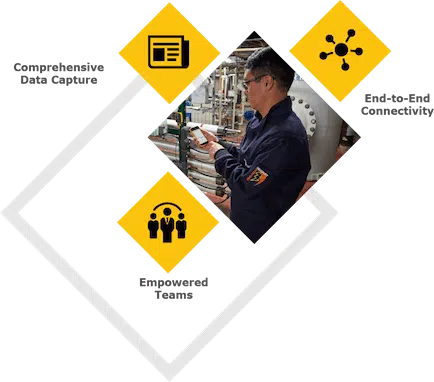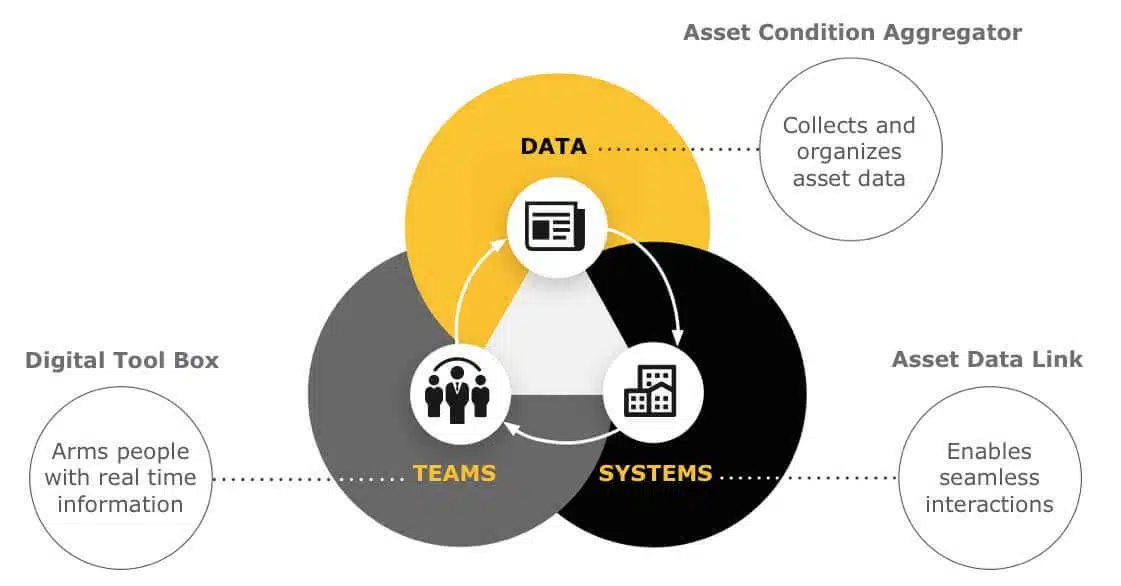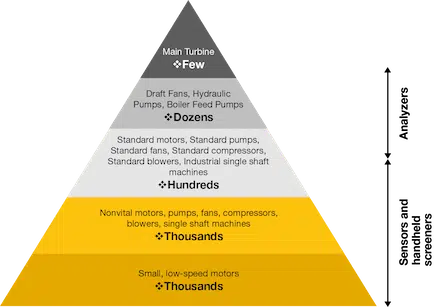Industrial production is experiencing a rapid transformation via the technological impact of the Industrial Internet of Things (IIoT) and causing a mass “re-think” of today’s production norms. Without a doubt, leveraging the IIoT technology during design, commissioning, control and operations has seen early implementation and successes.
“For automation, control and process management, the industry has been collecting data and using it to inform actions for years,” said Kevin Clark, former VP, Fluke Accelix. “The ‘newness’ of the IIoT is where the data can be stored (such as in the cloud), how it is analyzed, and then the capability to do something about it.”
However, maintenance and reliability (M&R) teams may struggle to collect and use actionable asset data with IIoT technologies, but why? According to a May 2018 study, “the most significant inhibitor of IIoT for predictive maintenance deployment is a skill shortage of big data scientists and a lack of understanding of Industry 4.0 [IIoT].”1 Despite this, organizations that implement a practical strategy can transform M&R into a business value engine. Though practical strategies are hard to come by, this white paper examines the underlying barriers and presents the concept of a connected reliability framework that can be used to overcome them.
Barriers to adoption
Although the IIoT could help most M&R teams streamline work processes and improve efficiency, uptime and overall asset health and reliability, these teams are often unable to take advantage of it.
“Reliability, maintenance and repair have not benefited as much from the collection and usage of cloud-based data. The majority of day-to-day maintenance and monitoring activities remain manual and often reactive, particularly on noncritical equipment (in the Tier 2 and lower categories),” Clark said.
Many factors combine to limit M&R teams’ ability to adopt IIoT strategies and technologies. These include:
- Many M&R programs currently rely on scheduled and route-based maintenance; the time involved to move away from reactive and preventive to predictive and condition monitoring strategies can appear insurmountable
- The historically high cost of condition monitoring hardware and software
- Limited access and flexibility of IT, including cybersecurity concerns
- Disparate data streams and/or historical data in silos with no connectivity
- Culture change, including training and buy-in to new tactics
The opportunity
More than 90% or 64 million machines in the world could benefit from sharing health and performance data but may not have built-in network connectivity.1 As a result, many of these assets may be unmonitored or uninspected. A connected, cost-effective, affordable reliability technology could enable M&R teams to maximize uptime for assets that are unmonitored and uninspected.
Some M&R teams may think they are not ready to make the technology or cultural changes necessary to implement IIoT technology systems. However, facilities and plants must accelerate their journey because making the move is no longer a question of if but when. Transforming the IIoT from a pie-in-the-sky promise to a daily reality that drives increased value from the assets already in operation will separate the M&R innovators from the old guard.
Studies have shown, if companies do not make the shift, their competitors will, leaving those that do not lagging. One study by SAP in 2017 indicates that Internet of Things (IoT) innovators are: “more likely to be world-class manufacturers … more likely to be an IoT leader in their industry … and far more likely to have increased profits in the past year from IoT…” than those who did not leverage the technologies.2 The majority of facilities and plants that implement IIoT technologies will see business value, often exponential, in the form of time and cost savings that result from more efficient work processes, fewer mistakes via data entry errors, increased uptime and decreased equipment failures.
How do teams that are just beginning the reliability journey or even those further along in their maturity reap all the rewards available through IIoT adoption and become a world-class M&R team?
The solution: Connected reliability

Figure 1: The three requirements for connected reliability
To move from reactive strategies, manual data entry or potentially time-wasting, route-based activities, facilities need a strategy for connecting assets, systems, and people – quickly turning data into insights to drive better outcomes. They can do this with a connected reliability framework, which gives teams a roadmap for moving past incremental gains to make a quantum leap to an ideal setup.
To make the future state a reality today, a connected reliability framework (see Figure 1) must consist of three essentials:
- Comprehensive data collection
- End-to-end connectivity
- Empowered teams
Comprehensive data collection
Teams must be able to use a technology mix to capture and aggregate actionable data for decisions about asset reliability and maintenance strategies. However, barriers exist that frustrate comprehensive data collection. Some of these are similar to the factors that affect IIoT technology adoption including:
- The team’s position in the reliability journey, relying heavily on scheduled/reactive maintenance with few sensors on assets
- The cost of condition monitoring technology
- Disparate data sources causing siloed and disconnected views with multiple points of interaction
- Missing or isolated equipment data
- Culture change
All data sources (mechanical, electrical, thermal, control, process and operations, building management) and types (portable, wireless and software) should be combined and leveraged to monitor and assess assets and systems.
Tools, sensors and other technology and software that can automatically aggregate data for analysis are foundational features of a connected reliability framework. However, available solutions often focus on just one type of monitoring (such as vibration), leaving it up to the plant team to manage the complicated issue of aggregating this data with other sources for a complete picture of asset health.
A robust enterprise asset management (EAM) or computerized maintenance management software (CMMS) system should also be included for insights. The EAM/CMMS must be fully implemented with an asset library and hierarchy and the ability to integrate data from many different sources.
“Integration of data from multiple sources allows for faster and better maintenance decisions. Ultimately, the EAM/CMMS should have the ability to integrate with machine data that provides actionable, event-driven processes,” said Gregory Perry, CRL, senior consultant, Accelix.
End-to-end connectivity
When collecting data from disparate sources, most M&R teams do not have clear insight into all the data because of the proprietary nature of most systems and technology. The daily reality is that many organizations must contend with siloed applications and islands of data, and M&R teams are asked to fill the gaps. Data from all sources must be integrated for a total view of all assets and systems.
“The flexibility of current and emerging technology leaves no room for barriers. M&R personnel must be able to collect asset and system measurements however they want, be that with a handheld meter, a wireless sensor, supervisory control and data acquisition (SCADA), or any other condition/process data. This multisource information can then be automatically stored for future study and analysis in one location, functioning in lock-step with the EAM/CMMS. Interoperability is the key to ensuring that plants and other facilities have all the data they need from all data sources in one place for full evaluation,” Clark said.
Teams require (and are beginning to demand) immediate connectivity from their assets to their EAM/CMMS and back again. Connected reliability should be implemented in a nondisruptive way. Most plants do not have the time or budget for million-dollar overhauls to key systems, so software solutions must have open architectures to extend the life of existing infrastructure investments. Mobile hardware must deliver new levels of affordability. An open, connected reliability framework enables organizations to instrument more assets with advanced sensor technology. These framework ingredients empower teams regardless of the team’s position on the reliability journey.
Empowered teams
A complete connected reliability framework must economically and efficiently meet M&R teams where they are in the reliability journey. With comprehensive and fully integrated data driven by technology and software, mobile connectivity can be achieved, allowing teams to have everything they need in one location. Teams using a connected reliability framework are empowered in many ways:
- Empowered with the bigger picture
- Empowered with mobile access to actionable data anywhere and at any time
- Empowered to make the right decisions at the right time and take the right action
As information seamlessly flows to an EAM/CMMS, work order generation and email notifications are accessible on any device whenever they are needed.
Mobile data also provides flexible access to analytics and reports. M&R personnel receive the information they need to accurately prioritize their activities and efficiently do their jobs. Instead of spending time examining healthy assets, they focus their energy on the right asset at the right time.
The ultimate promise of connected reliability is full-time access to the data and analysis needed by those charged with assuring asset health so that they successfully meet their goal: equipment reliability. Providing continuous, actionable data to the M&R team is the final and most important piece of any connected reliability framework.
Accelix: A connected reliability framework
Accelix delivers on the promise of connected reliability. It is a transformative set of tools, sensors and software enabling M&R teams to move confidently ahead on their journey to becoming a business value engine — maximizing uptime, enhancing asset value and improving competitive advantage. It provides a practical and cost-effective way for organizations to leverage IIoT data and move to reliability-based solutions.

Figure 2: Data + Connectivity + Action = Reliability
In building out the Accelix framework, Fluke leveraged its unique breadth of tools, sensors and software to gather a consolidated trove of actionable data and connect that data to the systems and teams already in place. The Accelix connected reliability framework offers all the essentials that M&R teams need — such as real-time EAM/CMMS connectivity, cloud-based software to aggregate and integrate data from all sources, and handheld tools and sensors to collect information on lower-tier assets. Lower-tier assets are those not deemed directly critical to the process and operations — those assets that will not shutdown operations were they to fail.

Figure 3: Tiered maintenance allows all assets to be screened, regardless of criticality level.
“From an overall market trend standpoint, there is a growing demand for tools which do more than simply provide measurements,” said Frederic Baudart, senior product application specialist, Accelix. “Fluke is addressing this category through its Accelix Connected Reliability Framework, which includes connected tools, sensors and the integration of data, including data from third-party devices and systems. The acceleration change in reliability strategy is fueled by the needs of artificial intelligence and machine learning.”
No data silos
Accelix removes data silos, giving teams the path to new competitive advantages because they make better decisions, uptime is maximized, and asset value is enhanced. With its Condition Data Aggregator (CDA), Accelix captures the industry’s most comprehensive asset health data from handheld tools and sensors and sends this information directly to the EAM/CMMS.
The CDA captures data from:
- Handheld tools and route-based data
- Accelix framework sensors
- Building management systems
- SCADA systems
- Any other third-party technology or system
Whether M&R teams have an existing EAM/CMMS or must purchase new software, Accelix can economically and flexibly meet these teams where they are along the path of M&R. This framework is an easy way to aggregate all critical data, eliminating the gaps that often frustrate M&R decision making, providing comprehensive data collection.
Full integration with mobility and automatic work orders
The Accelix connected reliability framework offers complete visibility without replacing key systems, delivered by its non-disruptive open architecture that can extend beyond Tier 1 equipment to serve most plant assets.
IIoT-enabled software systems within the Accelix framework can leverage the Asset Data Link that automatically connects data into virtually any EAM/CMMS, enabling new levels of visibility and management. While these components are considered essential to aggregate all asset data on a single pane, the entire framework does not need to be implemented at the same time. M&R teams can use mobile apps, mobile sensors and a connected reliability road map that enables them to start with one solution and grow as capabilities and budgets allow.
Guided teams: From reactive to proactive
With Accelix, M&R teams are empowered because they can realize practical progression from reactive strategies to predictive and reliability-based maintenance with minimal need for outside experts. The Digital Tool Box arms M&R teams with mobile accessibility that delivers information from multiple systems to one location, boosting productivity but more importantly enabling the right actions to be taken at the right time.
With a fully connected and implemented EAM/CMMS, work orders, alarms and other processes are automated, and failures are minimized. Technicians and engineers spend their work life proactively, not reactively repairing issues and swimming in asset downtime. Instead of M&R activities being viewed as a necessary cost center, teams can maximum their contributions to the bottom line as tight-knit crews leveraging new expertise and real-time capabilities.
The working man’s IIoT
In short, the Accelix framework is “the working man’s IIoT” – a practical roadmap for IIoT leverage. It was developed through years of research and customer feedback. The Accelix Connected Reliability Framework transforms a facility’s M&R team into a business-value engine, delivering:
- Maximized uptime
- Enhanced asset value
- High return on investment per maintenance dollar
This white paper originally appeared on Accelix.com, to which eMaint is tied. To read the results of our vision in the Gartner report, head to our blog post.
Resources
- www.accelix.com/community
- www.smrp.org
- www.reliabilityweb.com
- www.eruditio.com
- www.hpreliability.com
- www.mobiusinstitute.com
- www.cbmconnect.com
References
- Jalan, Arnav. “The Future of IIoT Predictive Maintenance,” Emory University and Presenso, https://www.presenso.com/blog/emory-research, May 28, 2018.
- “Catch up with IoT Leaders,” SAP.
